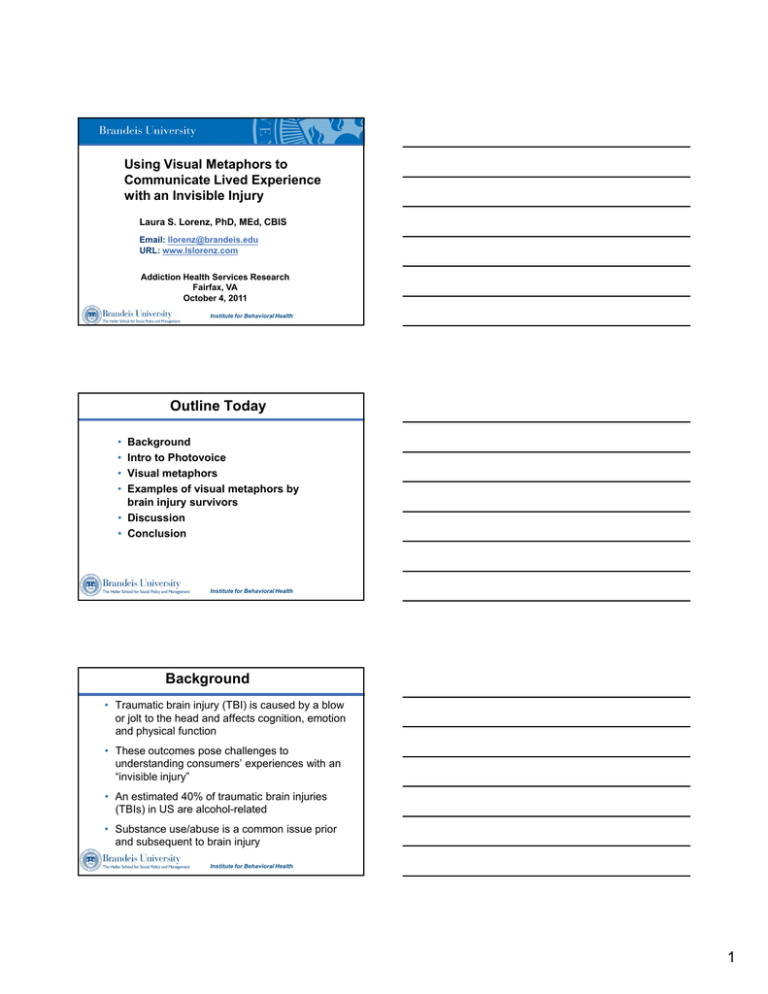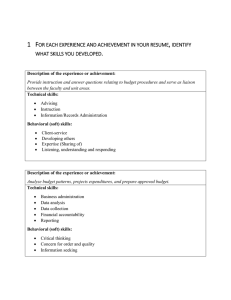Lorenz, Laura S.
advertisement

Using Visual Metaphors to Communicate Lived Experience with an Invisible Injury Laura S. Lorenz, PhD, MEd, CBIS Email: llorenz@brandeis.edu URL: www.lslorenz.com Addiction Health Services Research Fairfax, VA October 4, 2011 Institute for Behavioral Health Outline Today • • • • Background Intro to Photovoice Visual metaphors Examples of visual metaphors by brain injury survivors • Discussion • Conclusion Institute forforBehavioral Health Institute Behavioral Health Background • Traumatic brain injury (TBI) is caused by a blow or jolt to the head and affects cognition, emotion and physical function • These outcomes pose challenges to understanding consumers’ experiences with an “invisible injury” • An estimated 40% of traumatic brain injuries (TBIs) in US are alcohol-related • Substance use/abuse is a common issue prior and subsequent to brain injury Institute for Behavioral Health 1 A Photovoice Path Ask people to represent their lives, point of view and experience using photographs and narratives (Wang & Burris, 1997) A Photovoice Path Ask people to represent their lives, point of view and experience using photographs and narratives (Wang & Burris, 1997) A Photovoice Path Ask people to represent their lives, point of view and experience using photographs and narratives (Wang & Burris, 1997) 2 Participant Photo-taking Practices • Disposable cameras with 27 exposures each • 1 to 3 cameras each--15 and 50 photos each • Photo content more important than artistic quality • Some participants contributed family snaps • Some gave the camera to others • 24 of the 50 photos they discussed and selected for wider sharing were visual metaphors Institute for Behavioral Health A Photovoice Path Ask people to represent their lives, point of view and experience using photographs and narratives (Wang & Burris, 1997) Photovoice • Photovoice is participatory action research (Lorenz and Kolb 2009) • Similar to qualitative interviews, furnishes opportunity to have a voice—a say—in a research context (Mishler 1986/1991) • Goes further than qualitative interviews by providing: a) Multiple occasions to share experience b) Opportunities to contribute to data analysis, codifying efforts, policy and outreach (Wang, Yi, Tao, and Carovano 1998) Institute for Behavioral Health 3 Metaphor • Transfers the attribute of one entity to another: e.g. “he is my rock” • Allows people to express experiences and feelings that may be difficult to convey through words alone or are otherwise elusive (Ortony 1975; Charon 2006) • Is commonly used in everyday communication— but the metaphors they used were not “common” Institute for Behavioral Health How Photovoice Works Creating visual metaphors of experience involves: • Critical thinking • Giving shape to understanding • Distilling the meaning of experience (Wang et al 1998; Feinstein 1982) Discussing visual metaphors and writing about them for outside audiences: • Contributes to making meaning and coping with the realities portrayed (Charon 2006) Institute for Behavioral Health Inspiration for this Study I am a normal person with part of my head off in Never Never land. (Will I ever retrieve it?) Prigatano 1989 Institute for Behavioral Health 4 What Do You See? A visual metaphor that has inspired many others since. Source: Pre-pilot study 2005 Photographer: Laura Foley Institute for Behavioral Health That’s How I Felt Gthat’s how I feltGright after my accident, that there was no connection and there were so many missing links as I tried to begin living againGit was kind of like living in the middle of nowhereGWhen I saw that, well, that seemed like a perfect way to sum it all up, you know Source: Pre-pilot study 2005 Photographer: Laura Foley Institute for Behavioral Health What Do You See? The previous photo inspired this visual metaphor. What do you see? Source: Brain Injury X-Posed 2006 Photographer: Judy S Institute for Behavioral Health 5 Inside My Head The shell of my life became broken. Inside my head is scrambled with strands of my life no longer blended. Source: Brain Injury X-Posed 2006 Photographer: Judy S Institute for Behavioral Health What Do You See? Source: Brain Injury X-Posed 2006 Photographer: David S Institute for Behavioral Health Running on Ice GImagine yourself trying to run on iceGThe faster you run, the more you get nowhere. These images parallel how each and every day of my life begins since I suffered my brain injury. I seem to spend a whole lot of time getting nothing accomplished. 6 What Do You See? This visual metaphor became the representative image for the group exhibit. Source: Brain Injury X-Posed 2006 Photographer: Peggi R The Journey ‘It’s a muddy, rutty, hands-and-knees crawl up to the first rung of the ladder that begins to make some semblance of sense—and then you get to begin to really struggle. The climb does not and will not end. There is no final healed bone or mended tear of the skin to get over. Sometimes weekly, and sometimes daily there is a new step to attempt to get to your “new self.” You can’t even ever hope to get back to your “old self.” Oh well Maybe there will be a good view on this journey that I hadn’t expected...’ Source: Brain Injury X-Posed 2006 Photographer: Peggi R Scientific Poster Photovoice as Research: One photo and caption from every participant One from every exhibit theme Facilitators were co-authors Showed study as research Showed brain injury research, policymaker, and clinical audiences that brain injury survivors can be researchers and experts—Disruptive! 7 Scientific Poster The exhibit themes became a narrative—and a metaphor for “the journey” of living with and healing from brain injury: The Journey Lost Dreams Chaos Challenges Strategies My Advocacy Story Comfort and Support Acceptance Hope for the Future Discussion • Visual metaphors bring emotions and life experience into the research conversation (Lorenz 2010; Berland 2007). • Taking photographs that depict metaphors gets at tacit (invisible) aspects of experience—both suffering and healing. • Visual metaphors contribute to dialogue as they create a bridge between the lifeworld of the survivor and the larger society and foster new knowledge (Shiff 1979) • Creating visual metaphors that reflect experience is a cognitive act. Institute for Behavioral Health Discussion • Visual metaphors are “frozen records” of reality, but the act of creation changes experience and reality (Feinstein 1982). • Metaphors’ symbolic nature encourages construction of new meaning through the lens of personal experience. • Negotiating meaning can lead to developing new insights and meanings and contribute to healing or recovery (Ylvisaker et al 2008). • Dialogue about abstract representations of life experience can be transformative when it (a) helps individuals living with TBI to gain perspective on their lives and (b) helps audiences to gain greater awareness of and empathy for survivors’ struggles in turn. Institute for Behavioral Health 8 Discussion • Does the transformative nature of photovoice stem from the fact that it is a PAR methodology? • Does the transformative aspect require a group context? Institute for Behavioral Health What Do You See? Experience with individual survivors suggests that the group context is not essential. Source: Personal photovoice project 2009 Photographer: Molly R Institute for Behavioral Health Leaving the Nest I was like a bird hatching and ready to leave the nest to try a new beginning. Did I have the courage to fly on my own? I sure was scared. Now I know I can soar, yes I “can”. Source: Personal photovoice project 2009 Photographer: Molly R Institute for Behavioral Health 9 Conclusions • Visual metaphors played an important pedagogic role in communicating experience and emotional reality (Ortony 1975). • They stimulated new associations and tapped ‘new, different, or deeper levels of meaning’ (Feinstein 1982) • Grouping photos and captions into themes fostered a sense of shared experience among participants and resulted in an ‘interpretive account’ of living with brain injury (O’Connor and Chamberlain 2000). • Study process and products appear to have helped participants and audiences to see lived experience with brain injury in a more sympathetic and respectful way. • The mutual learning that occurred affected me as well. Institute for Behavioral Health What Do You See? Source: Lorenz 2008 Photographer: Author Institute for Behavioral Health Conclusions • Metaphor: the way the brain travels (Charon 2006). • In creating visual metaphors, participants “traveled” to the past and the future, to reveal the pain they feel at their losses and to share their sources of hope. • Visual metaphors have allowed participants to transcend time, place, and their identifying condition of brain injury (Radley 2009). • Photovoice helped brain injury survivors to overcome communication and memory challenges and experience success at having a say in research, policy, and clinical contexts. Institute for Behavioral Health 10 Conclusions • • • Photovoice exhibit presents a multifaceted view of brain injury: Negative view—Lost Dreams Positive view—Acceptance A danger: Seeing participants as so capable they no longer need assistance Greater danger: Seeing brain injury survivors as merely victims, and not as feeling actors on a journey similar to our own: to find meaning and purpose in life Institute for Behavioral Health References Berland, Gretchen. 2007. The view from the other side--Patients, doctors, and the power of a camera. The New England Journal of Medicine 357 (25): 2533-2536. Charon, Rita. 2006. Narrative medicine: Honoring the stories of illness. New York: Oxford University Press. Feinstein, Hermine. 1982. Meaning and visual metaphor. Studies in Art Education 23 (2): 45-55. Lorenz, Laura S. 2010. Discovering a new identity after brain injury. Sociology of Health & Illness 32 (6): 1-18. Lorenz, Laura S, and Bettina Kolb. 2009. Involving the public through participatory visual methods. Health Expectations 12 (6): 262-274. Mishler, Elliot G. 1986/1991. Research interviewing: Context and narrative. Cambridge, Massachusetts: Harvard University Press. O'Connor, Kay, and Kerry Chamberlain. 2000. Dimensions and discourses of meaning in life: Approaching meaning from qualitative perspectives. In Exploring existential meaning: Optimizing human development across the life span, edited by G. T. Reker and K. Chamberlain. Thousand Oaks, CA: Sage Publications, Inc. Ortony, Andrew. 1975. Why metaphors are necessary and not just nice. Educational Theory 25 (1): 45-53. Prigatano, G. P. (1989). Work, love, and play after brain injury. Bulletin of the Menninger Clinic, 53: 414-431. Radley, Alan. 2009. Works of illness: Narrative, picturing, and the social response to serious disease. Ashby-dela-Zouch: Inkermen Press. Shiff, Richard. 1979. Art and life: A metaphoric relationship. In On metaphor, edited by S. Sacks. Chicago, IL: University of Chicago Press. Wang, Caroline, Wu Kun Yi, Zhan Wen Tao, and Kathryn Carovano. 1998. Photovoice as a participatory health promotion strategy. Health Promotion International, 13 (1): 75-86. Ylvisaker, M., McPherson, K., Kayes, N., & Pellett, E. (2008). Metaphoric identity mapping: Facilitating goal setting and engagement in rehabilitation after traumatic brain injury. Neuropsychological Rehabilitation, 18 (5/6): 713-741. Institute for Behavioral Health Thank you! Laura S. Lorenz, PhD, MEd, CBIS Institute for Behavioral Health Schneider Institutes for Health Policy The Heller School for Social Policy & Management Brandeis University Waltham, MA Email: llorenz@brandeis.edu URL: www.lslorenz.com Lorenz, Laura S. (2010). Visual metaphors of living with brain injury: exploring and communicating lived experience with an invisible injury, Visual Studies, 25:3, 210 – 223. Institute for Behavioral Health 11


